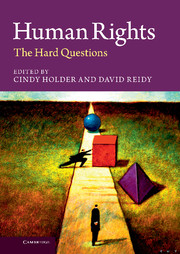Book contents
- Frontmatter
- Contents
- Figure
- List of table
- Notes on contributors
- Introduction
- Part I What are human rights?
- Part II How do human rights relate to group rights and culture?
- Part III What do human rights require of the global economy?
- Part IV How do human rights relate to environmental policy?
- Part V Is there a human right to democracy?
- Part VI What are the limits of rights enforcement?
- 17 Is it ever reasonable for one state to invade another for humanitarian reasons?
- 18 Conflicting responsibilities to protect human rights
- 19 Searching for the hard questions about women’s human rights
- 20 Are human rights possible after conflict?
- Part VII Are human rights progressive?
- Index
- References
20 - Are human rights possible after conflict?
Diary of a survivor
Published online by Cambridge University Press: 05 May 2013
- Frontmatter
- Contents
- Figure
- List of table
- Notes on contributors
- Introduction
- Part I What are human rights?
- Part II How do human rights relate to group rights and culture?
- Part III What do human rights require of the global economy?
- Part IV How do human rights relate to environmental policy?
- Part V Is there a human right to democracy?
- Part VI What are the limits of rights enforcement?
- 17 Is it ever reasonable for one state to invade another for humanitarian reasons?
- 18 Conflicting responsibilities to protect human rights
- 19 Searching for the hard questions about women’s human rights
- 20 Are human rights possible after conflict?
- Part VII Are human rights progressive?
- Index
- References
Summary
The challenges of protecting human rights after violent conflict are daunting. Often the very state institutions charged with protecting and promoting rights are the same ones that perpetrated crimes during the war, or must accommodate disarmed groups within new governance structures to move toward peace. Critical institutions to protect rights – the judiciary, the police, schools, hospitals and social welfare institutions – may have been destroyed and the economy and national treasury necessary to reconstruct them are empty. The rule of law exists mainly as an idea, and must be reconstructed to build social trust. Communities, families, have endured and fractured under the strain of violence, and must learn to live together again after so much loss. How is a survivor of mass violations of human rights to rebuild her life in such circumstances? How does her situated knowledge, as one who navigates such a complex and fraught terrain, provide further insights into the possibilities of realizing human rights after conflict?
Northern Uganda is the site of a decades-old conflict (1987–2008) between the Ugandan government and the Lord’s Resistance Army (LRA). During this war – which now continues in the Democratic Republic of Congo, South Sudan and the Central African Republic – the LRA abducted over 60,000 children and youths, forcing them to fight, act as porters and become wives to commanders (Blattman and Annan 2010). The Ugandan government pursued multiple military strategies to crush the rebels, one of which was to forcibly displace up to 90 percent of the population into poorly protected camps (Dolan 2009). Both the LRA and Ugandan People’s Defence Forces (UPDF) are responsible for inflicting grave atrocities on the civilian population, including rape, murder, lootings, arson, torture, beatings, forced enslavement and humiliation (Amnesty International 1999; Branch 2011; Human Rights Watch 2003).
- Type
- Chapter
- Information
- Human RightsThe Hard Questions, pp. 382 - 396Publisher: Cambridge University PressPrint publication year: 2013



